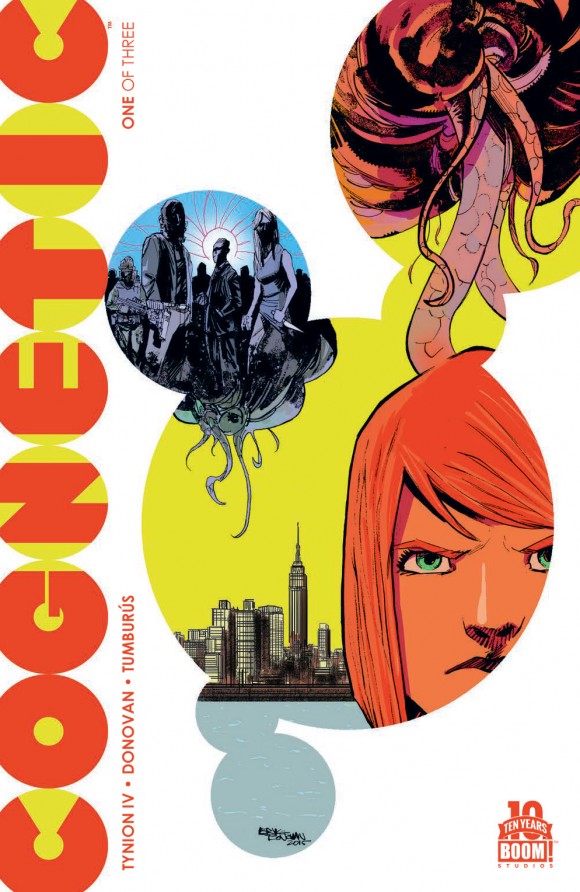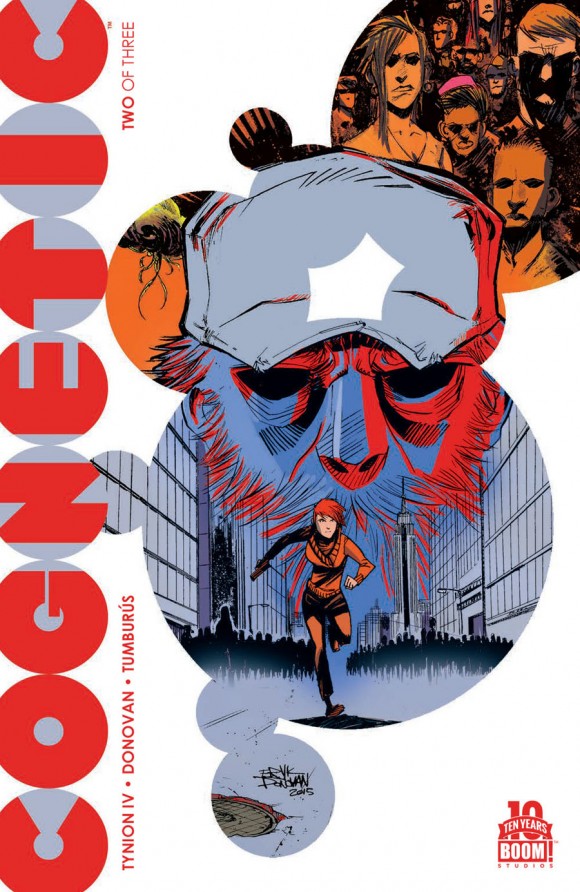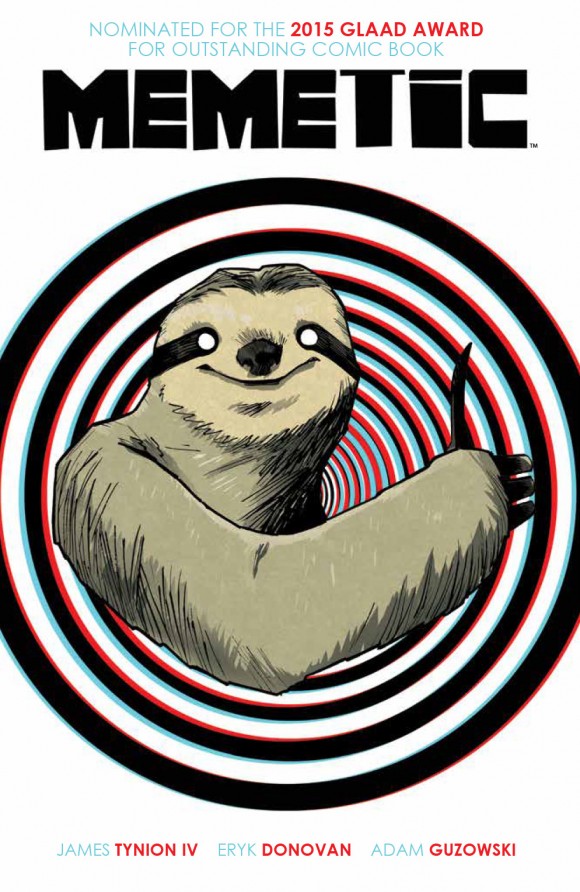Cognetic #2 is out this week from Boom! and we talk with creators James Tynion IV and Eryk Donovan.
By G.D. KENNEDY
On the last day of New York Comic Con, I found James Tynion IV and Eryk Donovan in artist alley at their shared booth, a few neat rows of the first issue of their (then) soon-to-be-released book Cognetic, and a large pile of stickers depicting a smiling sloth in front of a hypnotist’s wheel, the iconic image from their earlier book Memetic. There are no copies of Memetic to be found anywhere, however, despite the fact that the trade was about to come out; even though they’d brought stacks with them, the trade had sold out on Thursday, the first day of the show.
If you never read Memetic, it is Tynion and Donovan’s apocalyptic tale of a viral meme that is weaponized and brings about the end of the world. Cognetic is a conceptual sequel to Memetic, the second mini-series in a trilogy of post-apocolyptic tales which (at least so far) probe the weight of group-think versus individualism. For Tynion, these books are part of an ever-growing stable of work that varies from serialized superhero books with the Big Two to creator-owned works like The Woods with Boom! Studios, which is the story of a high school transported to a strange, foreign and violent world, itself recently optioned for television.
So, on Sunday afternoon at NYCC, I squeezed behind their table and we chatted for a bit about their current works and what is coming in the future.
***
G.D. Kennedy: So you were saying it has been an incredibly good weekend?
James Tynion: It’s been an incredibly good day, and an incredibly good weekend. I mean, New York is always crazy, but this has been — the amount of response we have been getting to Memetic, which we had advance sales a year ago in New York, and there are people who are coming back a year later. We sold through all of the trades we had for the entire weekend on Thursday, and it has gone crazy since then.
And we also have our advance copies of our next apocalypse, Cognetic, and people seem to be responding really well to that too. See, Eryk and I have been kind of baffled, like “Everyone loves us” or something. It’s been crazy.
Eryk Donovan: Yeah, it’s good. You’re proud of your work but there’s also that level of, “Here’s this crazy sloth with the hypnotic swirl with the eyes and the thumbs up. And people just love it. People are like, “What’s the sloth? What’s the sloth?” And the new book is a little more action oriented than Memetic was, and people are digging that idea too.
Cognetic is about a psychic entity that enters the Empire State Building, takes over the minds of everyone inside, and then just starts spreading out over the city and then into the world.
James: It’s a psychic contagion story. The biggest thing that sort of links our two apocalypses so far is the idea of identity. The thing I find more terrifying than anything is the idea that we as individuals don’t matter. That individuality as a concept does not matter. That we are sort of part of a larger system that does not care about our individual motives.
So I wanted to weaponize that in multiple ways, and I came up with three different ways to weaponize that and tell really creepy horror stories. We did the first one with Memetic, I think we did a very good job. We were nominated for a GLAAD award, people seem to be really responding to it, and now we have Cognetic, so yeah, it continues.
G.D.: So, in Memetic, we had the sloth. In Cognetic, what is the weaponized device?
James: With Cognetic, it is much more about the idea of someone exerting their will on other people. Cognetic is about using brain power to take over and spreading. It is a singular being who has this ability who is unleashed on the world.
G.D.: So as before it was like a neural network based on a memo, now it is —
James: It is a hive mind.
Eryk: I refer to them as, in Memetic, it’s the screamers — they get infected with the mets and they scream. In Cognetic, in our e-mails back and forth, I refer to them as thralls. That’s basically what they are: they are enthralled by this power that they can’t escape and their identity gets wiped away.
G.D.: In Memetic, the draw is this meme that represents absolute pleasure. In Cognetic, is it a similar reaction?
James: It’s much more brutal than that. It’s part of the idea that really terrified me. You see in lots of sci-fi a psychic controlling somebody’s mind, but then that person is left to go off to their own devices. I wanted to do a version takeover that to me makes more sense, something that feels a bit more organic, which is the fact that once my will is exerted over you, that overwrites your brain, and if I were to pull back from you, there’s nothing left — you drop dead. So you just become part of a larger system.
Eryk: Your body is a husk.
G.D: Cognetic and Memetic are part of a trilogy. What is the third weaponized mechanism of control?
James: Well, you’ll have to wait and see on that. We have a really cool idea that we are really excited about, but it might be a little while before you get to see it. Eryk and I have a lot of really cool projects coming up in the next year, but this project is something we are going to do right. You might have to wait a year or so before it comes out, but once it does, I know we are going to knock everybody on their asses.
G.D.: So what are some of the other cool projects that you have coming up?
James: In terms of stuff I can talk about, I’m currently working on Batman and Robin Eternal doe DC Comics. I have Batman/Teenage Mutant Ninja Turtles launching in December. I’m co-writing Constantine: The Hellblazer at DC with Ming Doyle and Riley Rossmo. I love working with Riley — my prize possession from this show is that I picked up a two-page spread from the first issue, so I’m real happy about that.
On top of that, I have The Woods continuing as an ongoing at Boom! Studios, we have one more issue of Ufology, and then they are actually collecting my first-ever creator owned comic, which was a Thrillbent comic which was called the Eighth Seal, and that is going to be coming out in print from IDW, although that is something I wrote years ago. It is not possible to write 20 books at the same time. It sounds like a lot, but I’m only writing four books a months.
Eryk: After the Cognetic arc gets wrapped, which will be soon, I have another mini-series which is a sci-fi/adventure thing coming up, but I can’t say much more about that. I have a couple of my own stories I’ve been mulling over in my brain, just writing little bits and pieces down here and there. And then, there’s always plenty of things that are going to pop up, so I’m expecting that next year will be pretty nuts as well.
G.D.: I heard something about a Woods TV show coming. Can you tell us a little more about that?
James: We have been optioned by Universal Cable Productions. The announcement just went out through Hollywood Reporter. It is the first step in a long road for actually seeing it on television, but it is a very exciting first step and I could not be prouder of anyone on the Woods team. I can’t say too much, but these are discussions now that the deal is in place — and the deal was finalized as it was announced, so now the deal is in place, we will start really developing it. Like I said, the first step in a long road.
G.D.: One thing I found fascinating about Memetic was the sloth, and how in reminded me of “The Entertainment” in Infinite Jest. Your story kind of takes it to the next level by weaponizing it. What was the genesis for weaponizing a meme?
James: The biggest thing that drew me to that was I was thinking a lot about — around the time that I came up with that, there were a lot of awful stories that were spreading around the news really, really fast, and a lot of opinion articles about that. Then the opinion articles would be totally disproven, but people would still react based on the opinions. It was the simple recognition that ideas spread faster than we can recognize whether they are a good idea or a bad idea. I wanted to make a story that tapped into that, which is very central to memetic theory, which comes from Richard Dawkins. The way to do that in the way that I felt would be most resonant would be to do that in the more standard definition of a meme in popular society.
G.D.: Which is something that I found fascinating. The use of the term and the way that it’s changed is a completely different meme than as it is traditionally defined.
Eryk: Such is the way of the meme. The word “meme” itself is almost like a microcosm of its own meaning in the way that we use it.
G.D.: For Memetic, you mentioned Richard Dawkins theory. Did you do a lot of research in support of that book, or was this more of a spontaneous concept?
James: I will be completely honest, it was a bit more spontaneous. I do research, but it was not — I didn’t sit down with the full library of Dawkins. I wanted to keep it on a nice level that would keep it accessible to anyone who wanted to pick it up, and therefore rely on the more contemporary definition of meme and memetics in general.
G.D.: The Woods has been going on for about two years now and we’re into the second chapter now. Things are getting . . . bigger. Can you talk a bit about where that is going?
James: The Woods is a story that — I’ve had the shape of the story from the beginning, but pieces keep changing. There was a major death in issue 12 that wasn’t planned. A major character of the series died in that issue and it changed the entire story after that, and made me so much more excited for it. The end game stays the same but the road to the end game, I keep breaking all the pieces and seeing how they fit together, which is something I really, really wanted to make happen in a cool way.
G.D.: Breaking the story as it goes — what was the impetus for this?
James: I really wanted to do — frankly, it’s the influence of Breaking Bad. I noticed the way that they would create a status quo and five minutes later, they would destroy every part of it, but they would still put the time in to make you comfortable, and make you feel safe. And then they would show you exactly how unsafe it was going to be. Every time they defined the rules, they broke the rules, and that has been incredibly influential to me in how I write the story. Why do the expected thing? You should always do the least expected thing. Including me — it keeps me on my toes. Especially, if I ask myself, if I break this, does everything become a mess, or does everything become more interesting. If the answer is it becomes more interesting, then it’s the right thing to do. The end.
G.D.: Are these violent changes mid-stream something he’s subjected you to along the way?
Eryk: Not so much with Memetic since he had they really solidified in his mind ahead of time. With Cognetic, we’ve had a couple places where we were not sure where we wanted to go, and we had a couple of conversations ahead of time about ideas that we wanted to and the characters, and what resonated within the ideas and concepts of the stories we wanted to tell.
And yet some of those things actually changed One of those things was — and I don’t want to spoil this because it happens near the end of the book — there’s a particular thing that happens where we went back and forth on this, asking, “Do we want to do this or not?” And then it was like, “Oh, let’s not do it.” And then we started the book, and James was like, “We’re doing it. We’re doing it.”
G.D.: Now you’ve worked on Memetic and Cognetic. What is your relationship like with respect to the work you put out? Have your roles changed?
Eryk: From the first thing we did together, which was a short in the Eisner- and Harvey-nominated In the Dark anthology that was just nominated this past year. So, that was the first thing we did. I just got the script and we did it as the script. We had a little back and forth and I might have asked a few questions via e-mail, but it was predominantly me just interpreting the script and coming up with it, and James being like, “Wow! That looks awesome.” Cool, man.
And then after that, we started doing this Thrillbent project called The House in the Wall, and that was one where we were involved the entire time, the three of us — including Noah J. Yuenkel, who is the co-writer and also writes Ufology with James — we all did that together. And that was one where things started to get looser because of our working relationship.
Now, we are at a point where James can send a script and have a page that is just, “So, here is what I want to happen on the page. Make it awesome.” And that is basically what I get. That is fine because he’s not doing it to me constantly to the point where I guess — he’s not doing a plot first kind of thing, but where you find the right places, he’s letting me open up and do what I want to do.
James: I know what needs to happen, but to define what happens panel-by-panel would be limited Eryk instead of letting him do what he is capable of. The reason we have been such a good partnership is because I know what I can expect of him when I let loose all of the reins.




